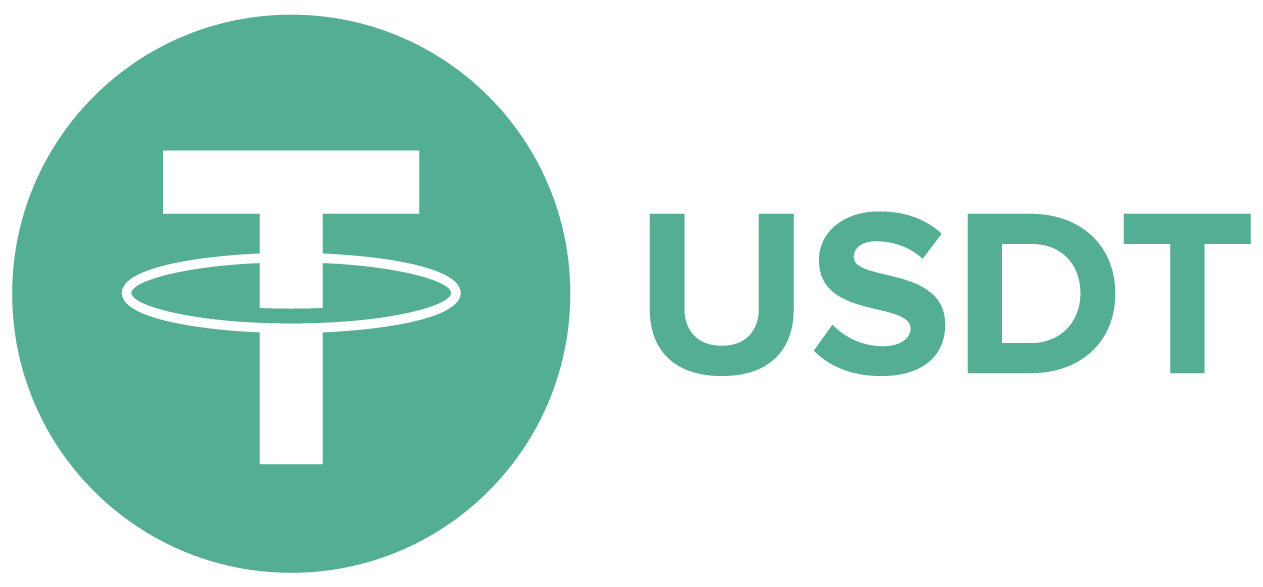Chapter 2 - How buying and selling occurs
Lesson 2.2 - Types of Orders
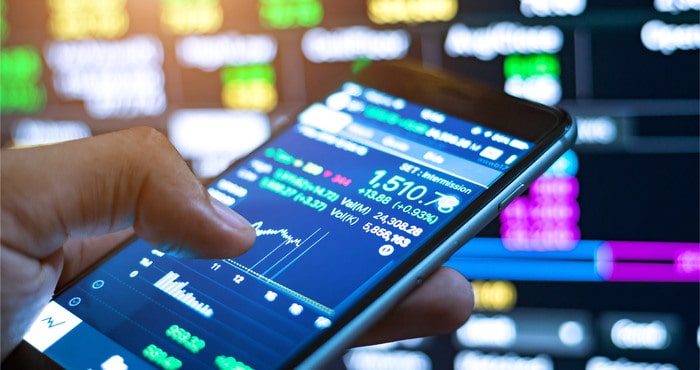
Traders in any kind of commodities are keen to monitor the price of the commodity that he intends to trade continuously in search of an appropriate opportunity.
For example, you may be concerned with car trading, so it is natural to be following the car prices continuously. If you find that the price of a car has become very low, you will be keen to buy it on the basis that its price will rise later, but you may find it appropriate to wait for some time before making the purchase, as you expect the price to drop further before going back up.
This needs continuous follow up from you. If you find that the price is suitable for purchase, you will either buy or wait until the price drops more then you buy.
Currency trading is the same way too.
When you monitor currency prices, you are waiting for the appropriate opportunity to buy a currency when you expect that its price will not decrease much later, rather it will rise again, and you may have to wait some time for the currency to drop further and proceed to purchase.
If we assume that you are monitoring the price of the Euro that is at the moment EUR / USD = 1.1200,
and you find, through your analysis of the price movement, that the price of the Euro will not decrease further, but rather it will rise again. What will you do?
Exactly. You will seize the opportunity immediately and buy Euros because you expect that the price will rise. You will ask to buy Euros at the current price.
When you do this, you have used the first type of order, which is the market order.
Market Order
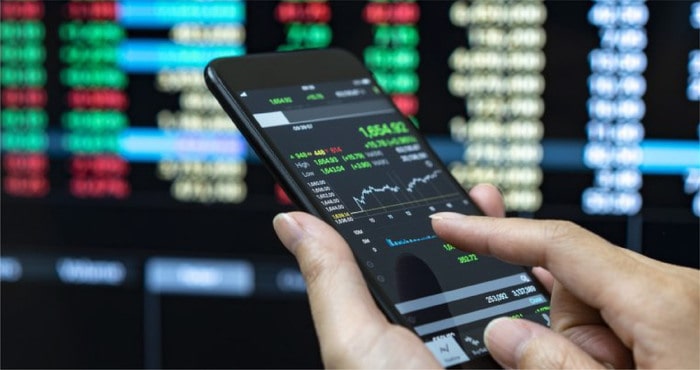
It is an order to buy or sell a currency immediately at the current market price.
Let us return to the previous assumption, where the EUR / USD price = 1.1200
Let us assume that, through your analysis of the Euro price, you expect that the price of the Euro will decrease further before it rises again, and that you expect that the price of the Euro will decrease first until it reaches EUR / USD = 1.1180 and then, it will rise again. What will you do?
Yes.. You have to wait for the price to drop to 1.1180 and then buy the Euros,
but that may require you to wait several hours until the price of the Euro reaches the price you expect. Does this mean that you have to remain glued to the computer for several hours while awaiting this moment?
Here comes the role of limit orders
Limit Order
It is an order to buy or sell a currency at a price predetermined by you. If the price of the currency actually reaches the price you specified, the order will be executed, and if it does not reach the predetermined price, the order will not be executed.
In our previous example, you would set the price of 1.1180 to buy, so you will tell your brokerage firm to buy you a lot of Euros if the price of the Euro reaches 1.1180. Then, you can leave the computer and take care of something else. If the price of the Euro actually reaches 1.1180, the firm will buy a lot of Euros for you, and if the price does not reach 1.1180, it will not execute the order.
You will do this by placing orders through the trading platform, granted to you by your brokerage firm to execute your positions in the market and follow the price there through. Trading platforms are usually equipped to apply technical analysis tools to prices, in order to predict future price movements.
Through the trading platform, you will find that executing orders, whether immediate or even deferred, is very simple.
The benefit of limit orders is to give you the opportunity to take care of other things without having to wait.
Types of Limited Entry Orders
There are four types of limit orders that cover all the possibilities of price movement of a currency, divided into two exit orders and two entry orders:
- Limit Exit Orders:
- Stop Loss Order.
- Limit Order
- Limit Entry Orders:
- Entry limit
- Entry stop
I hope that you do not feel confused by these types, the purpose of which is to cover all the possibility of price movement so that when you analyse the price of a currency, you can place these orders to be executed automatically without the need to remain glued to the computer for long hours. Because of these types of orders, the trader can make his work in speculating on currency prices a part-time job, where all you have to do is analysing the currency price, and if you reach a conviction about the direction of the price movement, you will place buy or sell orders and define them in advance. Then, you can leave the computer and take care of another job, being sure that wherever the currency price movement goes, your orders will be executed in the manner you specified in advance, automatically and without interference from you.
With a little practice, you will find that dealing with these orders is a very simple matter.
We will now explain in detail each type of the previously specified order.
Limit Exit Orders
Stop Loss Order
It is an order in which the price at which the position is closed is determined if the result is loss.
For example: Suppose you bought a lot of Euros at EUR / USD = 1.1200 on the basis that you expect the EUR to rise after that.
You know that for every point where the price of the Euro rises above the previous price, you win $ 10 in the Standard Account, and for every point in which the Euro price drops below the previous price, you lose $ 10.
Suppose you bought the Euro lot at the previous price, and you want to leave the computer and stop monitoring the price movement, but you are afraid that the Euro price will decrease further, which means that your loss will continue to increase. If the price drops 30 points, you will lose $ 300, and if it continues to fall more, and drops 60 points, you will lose $ 600, and so on.
You can set a maximum limit in advance that you can lose in this position by using a Stop Loss order by setting the price at which the position will be closed in the event of a loss.
In the previous example, you bought a Euro lot at 1.1200 on the basis that its price will rise, you will set the price at 1.1150 to limit the loss. Thus, you tell the brokerage firm to buy you a Euro lot at 1.1200, and if the price drops, and you starts losing until the price reaches 1.1150, they shall close the position for fear that the price will continue on the downside, so you have previously limited your loss in this position to 50 points.
After determining the price of the loss limit, you can leave the computer with a certainty that no matter how low the Euro price goes, you will not lose more than 50 points, because when the price of the Euro reaches 1.1150, the firm will automatically close the position, and you will lose no more.
A stop loss order is absolutely one of the most important orders in the financial markets, and certainly there are a lot of questions that revolve in the mind about this matter, such as how many points do I have to assign to a stop-loss order? What are the implications of not setting a stop-loss order? What is the basis for determining the point of the stop loss order execution? and many more.
The article here is dedicated to explaining the orders that you use as a market trader, but we did not go into more detail than that, especially with such an important and thorny issue such as defining the stop loss area that result in an actual loss. We may later devote other articles in which we talk more thoroughly about setting a stop-loss order.
Limit Order, commonly known as Take Profit.
It is an order in which the price at which the position is closed is determined in the case of profit.
For example: Suppose you bought a lot of British Pound at a certain price, and you expect the British Pound to rise by 80 points. In order to get the profit, you have to wait for the Pound to actually rise by 80 points, and this may require several hours, but here you can use a “Take Profit” order to determine the price at which you want to close the position in case of profit.
If we assume that you bought the British Pound at the price of 1.3000, and you expect the Pound to rise by 80 points. Then, you can place a take profit order at 1.3080, i.e. you tell the brokerage firm to close the position if the British Pound price reaches 1.3080. This order will be executed automatically without the need for your presence in this moment.
After placing this order, you can leave the computer, being sure that if the price reaches the point you set, you will be able to take profit without fear that the price will come back and go down, and you will lose the opportunity to get the 80 points.
A take profit order is the same as the stop loss order, as its use is also of the utmost importance. We realize that there are many questions in mind regarding this topic, but we confirm that this article is specifically dedicated for explaining the meaning of these orders and how to execute them, so we do not go into details of how to set take profit order prices.
However, later we will deal with this issue in more detail, and we will further address it, but here, we want to maintain our focus regarding the execution of orders and their meaning.
Now, we show you my dear reader, an illustrative example when there is a stop loss order, and a take profit order, when opening a buying position.
The following image is an hourly chart of the US Dollar pair against the Swiss Franc.
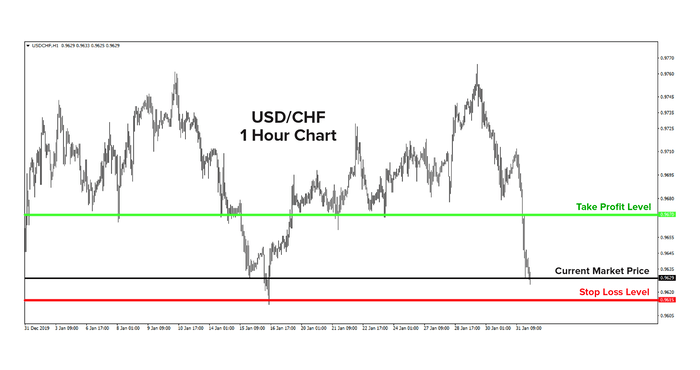
We believe that the US Dollar fell sharply against the Franc, and the current market price is 0.9629, and we believe that the US Dollar will rise again, within the range of 40 points. Now, we have executed a position to buy the US Dollar at the market price that is 0.9629, and set the price of 0.9670 for executing a take profit order. We also believe that the drop of the US Dollar to 0.9615 will push the Dollar further down. Therefore, we have placed a stop loss order at 0.9615.
In long positions, in this example, we have bought the base currency, the US Dollar. The stop loss order appears below the price movement, while the profit taking order is placed above the price action.
The following image is the 4-hour chart, of the GBP / USD pair.
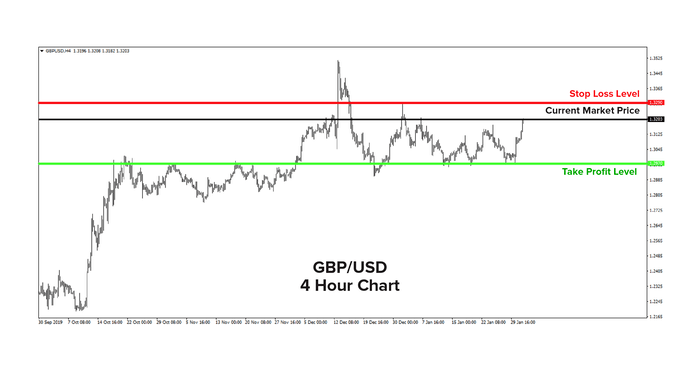
We believe that the British Pound will decrease, and that the current price at 1.3203 is an appropriate price to sell, so we will execute the sale at the market price. We think that the Pound will drop by approximately 230 points, so we set a take profit order at the level of 1.2970, and we also determined that the British Pound price will go up further if it reaches 1.3290, so we have set the stop loss order at 1.3290.
In short positions, in this example, we have sold the base currency, which is the British Pound, you will find that the take profit order appears below the price movement, while the stop loss order appears above the price movement.
Thus, as you can see, by using your stop order and limit order, you have set the maximum limit for your loss and profit in advance, after which you can leave the computer while you are sure that if the currency price reaches at any time the price you set for the take profit order, the position will be closed automatically by the firm to add the profit to your account, and if the price reaches the level you previously set to limit the loss, the position will be closed, and you will not lose more than the amount you specified, regardless of how much you reflect.
As you see, this is an excellent advantage in trading stock exchanges in general and in currency trading in particular. There is no possibility in any other field to determine your loss and profit in advance, as there is no possibility to get the profits while you are sleeping in your bed as you do when you trade in currencies !!
A stop loss order and take profit order are position closure orders, which means that whether you open your position immediately with a market order, or you open your position in a deferred manner, as we will explain later, in both cases you will set a stop-loss order and a take-profit order.
The following image, from the most common trading platform in the world (Meta Trader 4). We execute a British Pound short position, at the market price of 1.3203, and we set the level of 1.2970 for the take profit order, and the level of 1.3290 for the stop loss order. Then, we click on the Sell button, the process is executed, and orders are automatically executed later when prices reach the settled levels.
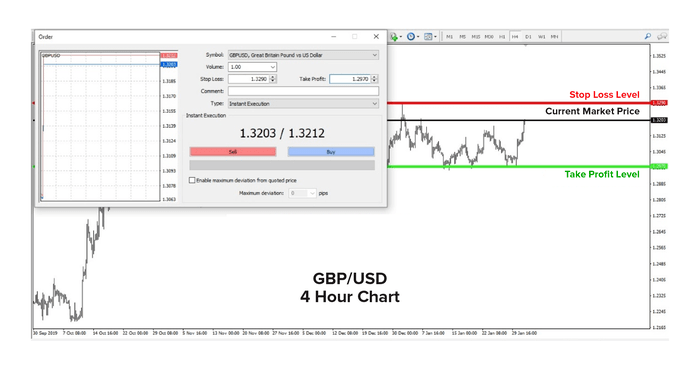
Limit Entry Orders
As you saw, the previous two orders are exit order, i.e. two orders by which you ask the brokerage firm to close the current position in the case of profit using the take-profit order, and in the case of loss using the stop loss order.
First, you must have opened a position to use the stop loss order and the take profit order,
but let us assume that you have analysed the price of a currency and reached a conviction that the price of this currency will rise, but not now. Rather, you expect it to drop first by 30 points, for example, and then rise again.
Here, although you are convinced that the price will go up, you cannot buy this currency, because you expect it to further drop in price, so why not wait to buy it at the lower price?
Let’s take an example: Suppose you analyse the movement of the British Pound and its current price is 1.3203, and you expect the price to drop first until it reaches 1.2970 and then it is expected to increases a lot .. What will you do here?
Yes, you will wait for the price to reach 1.2970 and then buy it, but this may require several hours. Do you have to remain glued in front of the computer while waiting for the price to decrease until you buy it?
The answer is absolutely you don’t need to wait all this time.
Here comes the role of limit entry orders
These are orders that allow you to open a long or short position at a certain price without the need to wait for the price to actually arrive. The order will be executed by the brokerage firm and a position will be opened by buying or selling the currency when it reaches the price you specified.
As if by this, you ask the firm to buy a lot of a certain currency if the price of this currency reaches such level because I expect that the price of this currency will rise later.
As if you ask the firm to sell your lot of a certain currency if the price of this currency reaches such level because I expect that the price of this currency will drop later.
The main advantage of limit orders is that they allow you to buy and sell when you find that the price is appropriate without the need to be constantly observing the currency price movement, but it is sufficient to specify the price at which you expect a good opportunity, and the order will be executed if the currency price actually reach the price you set. The order will not be executed if the price does not actually reach the point you specified.
In fact, when the price ever reaches a certain point it either continues its movement or bounce back therefrom.
What does that mean?
Suppose that the price of the Euro against the US Dollar is now EUR / USD = 1.1200, and suppose that the price began to rise until it reaches any point, say 1.1230.
In this case, it either continues to rise more or returns and decrease, and there is no other movement possibility.
If the price continues to rise, we say it is a continuous price.
If it reaches this point and reverses its direction, i.e. it starts to decline, we say that it is a rebound price.
Thus, there are two types of limit entry orders.
Limit Entry Order
It is an order to open a position to buy or sell a currency at a price when you expect that the direction of the price movement will rebound and reverse its direction after reaching that price.
Let’s take some examples:
Example (1):
The current price of the EUR / USD = 1.1092 and you expect the price to decrease until it reaches EUR / USD = 1.1060, and then the rise will resume, i.e. its direction will be reversed from downward to upward, what will you do?
The answer:
You will place a limit entry order at 1.1060 because we expect the price of the currency to rise after it reaches this point, and if the price already reaches EUR / USD = 1.1060, the firm will buy the Euro for you at the number of lots you set, and if it does not reach that point, the order will not be executed. This order will be a limit entry order because it is a price linked to the reversal trend of the price movement. It is among the pending orders in the trading platforms, and this case is called the Buy Limit.
Example (2):
The current price of the British Pound is 1.3203, and we expect through the analysis that the Pound will rise to 1.3300. Then, it will reverse its movement and return to decline. What will you do?
The answer: You will place a limit sale order for the Pound at the price of 1.3300, because you expect that the price will reach this point and then decrease, so you ask the firm to sell you Pound lot if the price reaches 1.3300, because you expect that the Pound price will decrease after that. This order will be a limit entry order because it is a price linked to the reversal trend of the price movement. It is among the pending orders in the trading platforms, and this case is called the Buy Limit.
STOP Entry Order
It is an order to open a position to buy or sell a currency at a price when you expect that the direction of the price movement will continue in the same direction after reaching that price.
Let’s take some examples:
Example (1):
The price of the US Dollar against the Japanese Yen is now USD / JPY = 119.20, and you expect the price to rise first until it reaches 119.50 before continuing to rise further. What will you do?
The answer: You will place a limit order to buy the US Dollar at the 119.50, and thus you ask the firm to buy you a lot of the US Dollar if its price rises and reaches 119.50 because you expect the price to start increasing further. The order will be executed when the price of the US Dollar actually reaches 119.50. This will be a stop entry order because it is related to the continuing trend of price movement.
It is among the pending order in the trading platforms, and this condition is called (Buy Stop).
Example (2):
The current price of the US Dollar against the Franc is 0.9629, and we expect if the Dollar continues to decline to the level of 0.9600, it will continue to decline against the Franc. What shall we do in this case?
The Answer: We will place a sale order for the US Dollar at the level of 0.9600, and thus we ask the firm to sell our US Dollar lot if the price of the Dollar reaches 0.9600 against the Franc because we expect that its price after that will continue to decrease.
This will be a stop entry order because it is related to the continuing trend of price movement. It is among the Pending Order in the trading platforms, and this condition is called (Sell Stop).
The following image shows a list of Pending Orders, including the four main cases of price movement, explained in previous examples. The image also shows that even in pending orders, the Stop Loss and Take Profit orders can be issued.
The image of the most common trading platform in the world called Meta Trader4.
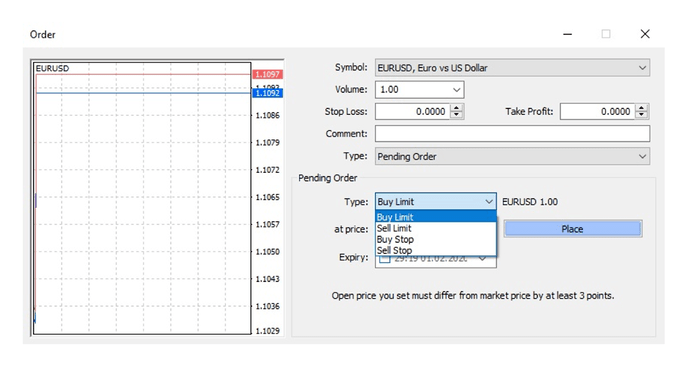
It's a bit confusing, isn’t it?!This is normal and expected, but you don't need to worry, practice is the best way to know these orders carefully, and then it's going to be very easy.
You may find some difficulty in applying the previous orders or even understanding them, but with a little practice, things will become fully clear, and you will know how easy it is to deal with the types of previous orders, that was set to achieve one purpose, which is to have orders to enter and exit positions in all the possibilities of price movement so as to helps you seize any opportunity on the one hand and reduce the risk of loss on the other hand.
We believe that the stop loss order is the most important thing ever, followed by the profit taking order, and then all positions opening orders come after them, so do not confuse yourself a lot with all orders, focus on the most important for you, and when you gain enough experience, you will be able to use the rest of the orders easily and conveniently.

 English
English





